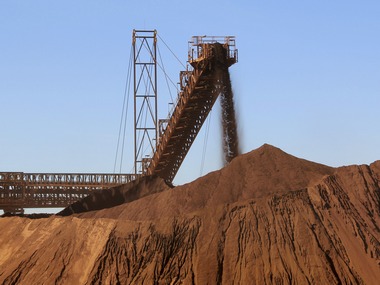The Indian government plans to launch a $35 billion (Rs 1.76 lakh crore) wave of public-sector investments to reverse a decline in the economy, according to a report in Financial Times.
The report said the government has ordered 17 state-owned companies to use money currently held in reserves to invest in a mixture of infrastructure projects and overseas energy purchases. Companies being asked to spend their cash reserves include Oil and Natural Gas Corporation (ONGC), Coal India and National Mineral Development Corporation (NMDC). The plan is expected to be implemented in the new financial year starting April, the UK-based newspaper said.
The idea is to encourage private-sector companies, which have practically stopped investing because of the economic slowdown and high interest rates, to follow suit.
[caption id=“attachment_187504” align=“alignleft” width=“380” caption=“Mining is probably one of the few sectors where PSUs are cash-rich. Reuters”]  [/caption]
Jump-starting the economy by boosting public-sector spending seems like a good idea, but it remains to be seen how this plan will be executed.
One, the truth is that barely a handful of public-sector undertakings (PSUs) actually have hefty bank balances (most of them will be in the oil and mining sectors). While the top PSUs might have cash to spend, the same can’t be said for several others. Indeed, quite a few have their own expansion plans lined up, so we’ll have to see whether this government-directed spending affects their long-term profitability in any way.
In addition, a recent BNP Paribas pointed out that some caution needs to be exercised when considering whether a PSU is cash-rich, because those cash reserves might be nothing more than a mirage. " Bharat Electronics, a state-owned defence company, for example appears to have large cash reserves but a significant part of that cash is due to advances collected against orders, and has to be invested in working capital," it noted. “Another example is Coal India - which has stated its intention of potential inorganic expansion, and therefore ‘spare cash’ could be about Rs 15,000 crore.”
Impact Shorts
More ShortsTwo, spending to create infrastructure seems good on paper; in reality, it will probably go the way of previous spending and get mired in a bunch of regulatory hurdles and environmental clearance delays. Most infrastructure projects across the country have been crippled by land acquisition problems and regulatory delays, which are really the biggest hurdles to further spending.
Across sectors, we have problems that go beyond a simple lack of spending. Power projects, for instance, are mainly stuck because of pricing and fuel supply issues. Coal production, on the other hand, is being hampered mainly by a lack of environmental approvals and land acquisition problems.
It’s difficult to see how even more spending without finding solutions to these problems will help. The government needs to fix the policy environment first before asking PSUs to spend more.
Three, the investment climate remains very poor and large-scale spending by PSUs might not necessarily change that. It speaks volumes that India’s largest private-sector company, Reliance Industries, which has oodles of cash, has chosen to use that cash to initiate the largest share buyback scheme ever seen in Indian corporate history, instead of going around snapping up assets either locally or overseas. If one of India’s canniest private-sector investors can’t spot any great investment opportunities at the moment, can PSUs do any better?
Businesses will not invest unless they believe they’ll get good returns for their investments and the operating environment becomes easier. Large-scale, government-directed public spending is unlikely to change their minds.
Four, there’s also the question of whether the government should be dictating to companies about when and how they should spend their cash reserves. True, government interference always exists in the case of PSUs, but directing them to spend their reserves when they themselves aren’t willing to do that is unreasonable. After all, everyone is probably all too aware of the pitfalls of investing in infrastructure-related projects in the current environment.
If the government just fixed the policy regime, it wouldn’t have to order state-run companies to spend on its behalf. It would happen willingly – and private businesses would follow.


)

)
)
)
)
)
)
)
)



